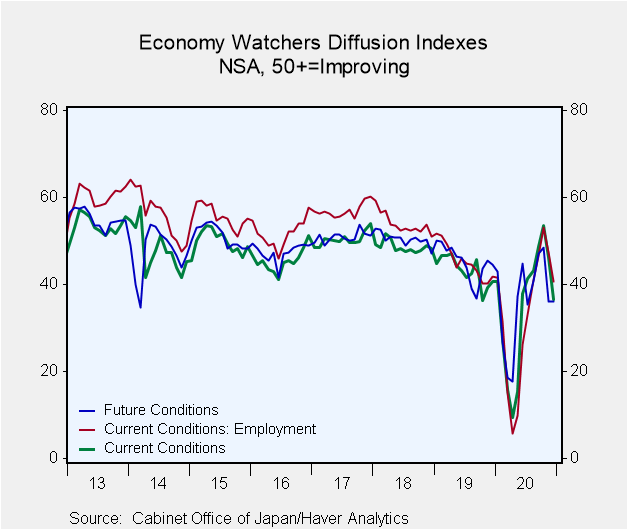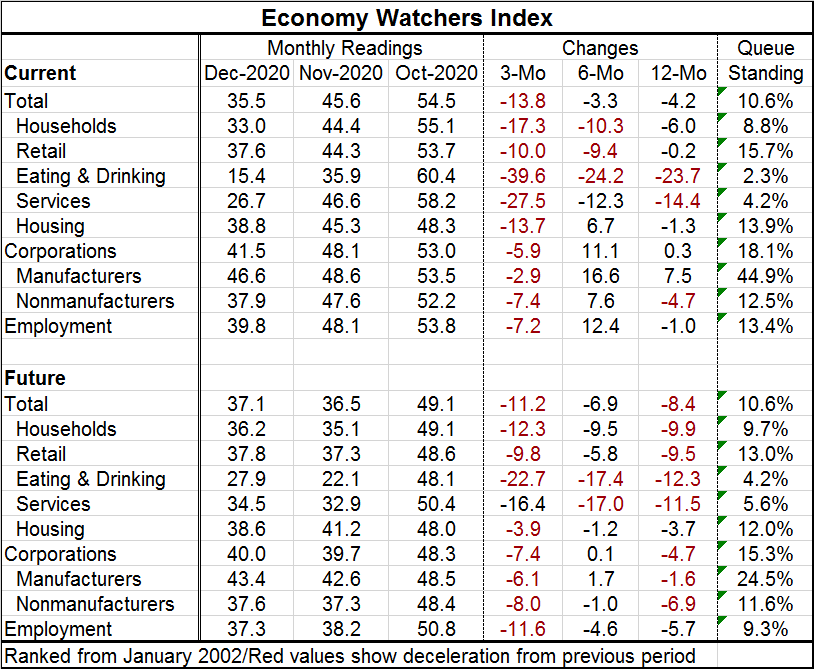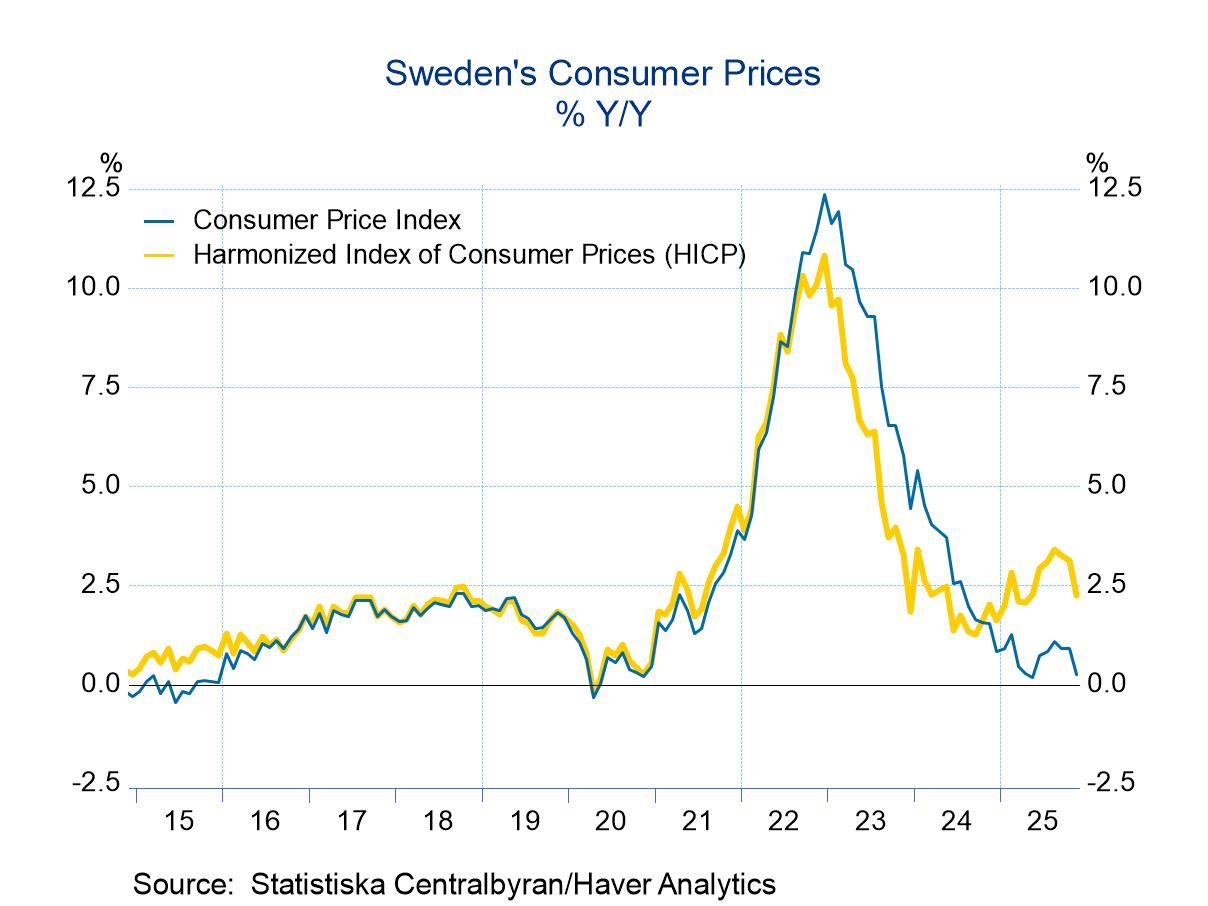 Global| Jan 12 2021
Global| Jan 12 2021Economy Watchers Index Has Conniptions
Summary
Japan's current economy watchers reading has plunged in December, falling to 35.5 from 45.6 in November. The index had increased monotonically from its April low until November when it slipped and now it has fallen for two months in a [...]
 Japan's current economy watchers reading has plunged in December, falling to 35.5 from 45.6 in November. The index had increased monotonically from its April low until November when it slipped and now it has fallen for two months in a row and in December it has fallen sharply. Japan's declaration of a state of emergency in the Tokyo area has only just been made early in 2021.
Japan's current economy watchers reading has plunged in December, falling to 35.5 from 45.6 in November. The index had increased monotonically from its April low until November when it slipped and now it has fallen for two months in a row and in December it has fallen sharply. Japan's declaration of a state of emergency in the Tokyo area has only just been made early in 2021.
A State of Emergency
Japan has a 'State of Emergency' declared for Tokyo and is considering broadening the regions for that declaration beyond Tokyo. The virus is spreading and the declaration of a 'State of Emergency' gives local authorities a legal basis to restrict movement and business operations. Only the Prime Minister can declare a state of emergency not the prefectures (in the U.S., governors have equivalent powers within their states; not so in Japan). But in Japan the prefectures of Osaka, Kyoto and Hyogo have asked to be included in the state of emergency edict. Japan also has found a new strain of the virus different from the variants reported in the United Kingdom and in Africa.
Japan and the slippery slope
While Japan's intensity of infection is not as high as in many Western countries, Japan- especially Tokyo- has high population density which could put it on a very slippery slope for the spread. So Japan's numbers are low, but its risk are high and the infection and death curves are rising fast, prompting the Prime Minister to act. Japan's death toll is at about 75 per day at its recent peak (source) compared to 4,132 per day in the U.S. (source). In Japan, it's all about the slippery slope, not the current extent of the spread.
The economy is feeling the pain
With Japan's infection rate having been on the rise since mid-to-late December, the economy watchers index registers growing concern about the economy and the observation of lessening activity. The current index peaked in October and has slid from 54.5 at that local peak to 35.5 in December. The State of Emergency was declared in January, not in this period. The current index for 'eating and drinking places' fell from a reading of 60.4 in October to a level of 15.4 in December. That December reading is the weakest since May. The services sector in general also has fallen from 58.2 in October to 26.7 in December. That is also its lowest reading since May. The backsliding in Japan is real and is significant. In manufacturing, the index has fallen from 53.5 in October to 46.6 in December; for nonmanufactures, the index falls from 52.2 in October to 37.9 in December. The overall employment gauge has fallen fast, dropping from 53.8 in October to 39.8 in December.
Uniform and severe economic weakness
The queue standings are fairly uniformly weak. The main exception for 'strength' is for the manufacturing sector where the queue standing at 44.9% is still below its historic median calculated on data back to 2003. However, apart from manufacturing, the current queue standings range from a high standing of 18.1% (for corporations of all types) to a low of 2.3% (eating and drinking places).
A weak future index as well
The future index standings are similar to this array, with the manufacturing standings at 24.5% as the highest and all other standings ranging between 15.3% and 4.2%. Japan is not treating this as a one-off event that is going to go away soon. The future index is significantly weak across all sectors.
Comparing 'today' with 'tomorrow'
The queue standings are generally weaker for the future assessment than for the current assessments. There are only two exceptions to this and they are for eating and drinking places and for services and that is because those two industries have been clobbered so hard in the current period index. Actually, the standings for the overall current index and for the future index are exactly the same. Manufacturing is the sector with the biggest gap between its current queue standing and its future standing with the future standing much weaker, of course.
Japan's economy watchers index is back in the soup

Summing up
The graphic looks at the level of the index, not the changes. It shows that the three indexes it plots have been slipping since 2018 and reached a low at the height of the first wave of the coronavirus crisis in April 2020. However, the slippage in 2018 and 2019 was slow and steady. And while the virus hit 2020 very hard, it produced a sharp reversal as well. That reversal lasted about six months but has since soured. Japan is now is a disheveled state. It was caught in the crossfire of U.S.-China trade wars in 2019 and then it was blasted by the virus which is now making a comeback. Despite its low rate of infection, Japan is fighting the virus hard as it intends to keep the virus at bay.
Robert Brusca
AuthorMore in Author Profile »Robert A. Brusca is Chief Economist of Fact and Opinion Economics, a consulting firm he founded in Manhattan. He has been an economist on Wall Street for over 25 years. He has visited central banking and large institutional clients in over 30 countries in his career as an economist. Mr. Brusca was a Divisional Research Chief at the Federal Reserve Bank of NY (Chief of the International Financial markets Division), a Fed Watcher at Irving Trust and Chief Economist at Nikko Securities International. He is widely quoted and appears in various media. Mr. Brusca holds an MA and Ph.D. in economics from Michigan State University and a BA in Economics from the University of Michigan. His research pursues his strong interests in non aligned policy economics as well as international economics. FAO Economics’ research targets investors to assist them in making better investment decisions in stocks, bonds and in a variety of international assets. The company does not manage money and has no conflicts in giving economic advice.






